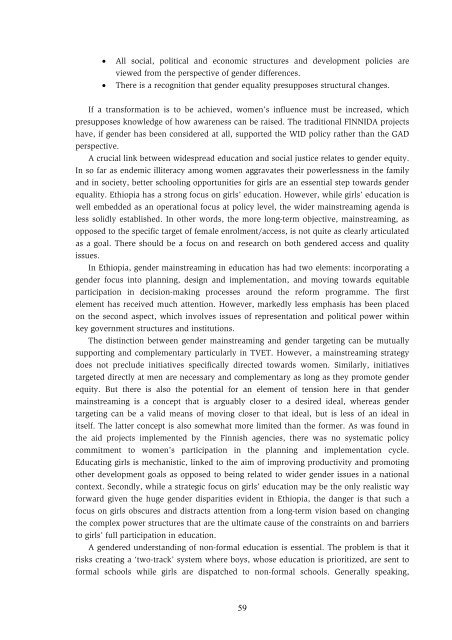Education and Training in Ethiopia An Evaluation of Approaching EFA Goals
Education and Training in Ethiopia - Koulutuksen tutkimuslaitos
Education and Training in Ethiopia - Koulutuksen tutkimuslaitos
- No tags were found...
You also want an ePaper? Increase the reach of your titles
YUMPU automatically turns print PDFs into web optimized ePapers that Google loves.
• All social, political <strong>and</strong> economic structures <strong>and</strong> development policies areviewed from the perspective <strong>of</strong> gender differences.• There is a recognition that gender equality presupposes structural changes.If a transformation is to be achieved, women’s <strong>in</strong>fluence must be <strong>in</strong>creased, whichpresupposes knowledge <strong>of</strong> how awareness can be raised. The traditional FINNIDA projectshave, if gender has been considered at all, supported the WID policy rather than the GADperspective.A crucial l<strong>in</strong>k between widespread education <strong>and</strong> social justice relates to gender equity.In so far as endemic illiteracy among women aggravates their powerlessness <strong>in</strong> the family<strong>and</strong> <strong>in</strong> society, better school<strong>in</strong>g opportunities for girls are an essential step towards genderequality. <strong>Ethiopia</strong> has a strong focus on girls’ education. However, while girls’ education iswell embedded as an operational focus at policy level, the wider ma<strong>in</strong>stream<strong>in</strong>g agenda isless solidly established. In other words, the more long-term objective, ma<strong>in</strong>stream<strong>in</strong>g, asopposed to the specific target <strong>of</strong> female enrolment/access, is not quite as clearly articulatedas a goal. There should be a focus on <strong>and</strong> research on both gendered access <strong>and</strong> qualityissues.In <strong>Ethiopia</strong>, gender ma<strong>in</strong>stream<strong>in</strong>g <strong>in</strong> education has had two elements: <strong>in</strong>corporat<strong>in</strong>g agender focus <strong>in</strong>to plann<strong>in</strong>g, design <strong>and</strong> implementation, <strong>and</strong> mov<strong>in</strong>g towards equitableparticipation <strong>in</strong> decision-mak<strong>in</strong>g processes around the reform programme. The firstelement has received much attention. However, markedly less emphasis has been placedon the second aspect, which <strong>in</strong>volves issues <strong>of</strong> representation <strong>and</strong> political power with<strong>in</strong>key government structures <strong>and</strong> <strong>in</strong>stitutions.The dist<strong>in</strong>ction between gender ma<strong>in</strong>stream<strong>in</strong>g <strong>and</strong> gender target<strong>in</strong>g can be mutuallysupport<strong>in</strong>g <strong>and</strong> complementary particularly <strong>in</strong> TVET. However, a ma<strong>in</strong>stream<strong>in</strong>g strategydoes not preclude <strong>in</strong>itiatives specifically directed towards women. Similarly, <strong>in</strong>itiativestargeted directly at men are necessary <strong>and</strong> complementary as long as they promote genderequity. But there is also the potential for an element <strong>of</strong> tension here <strong>in</strong> that genderma<strong>in</strong>stream<strong>in</strong>g is a concept that is arguably closer to a desired ideal, whereas gendertarget<strong>in</strong>g can be a valid means <strong>of</strong> mov<strong>in</strong>g closer to that ideal, but is less <strong>of</strong> an ideal <strong>in</strong>itself. The latter concept is also somewhat more limited than the former. As was found <strong>in</strong>the aid projects implemented by the F<strong>in</strong>nish agencies, there was no systematic policycommitment to women’s participation <strong>in</strong> the plann<strong>in</strong>g <strong>and</strong> implementation cycle.Educat<strong>in</strong>g girls is mechanistic, l<strong>in</strong>ked to the aim <strong>of</strong> improv<strong>in</strong>g productivity <strong>and</strong> promot<strong>in</strong>gother development goals as opposed to be<strong>in</strong>g related to wider gender issues <strong>in</strong> a nationalcontext. Secondly, while a strategic focus on girls’ education may be the only realistic wayforward given the huge gender disparities evident <strong>in</strong> <strong>Ethiopia</strong>, the danger is that such afocus on girls obscures <strong>and</strong> distracts attention from a long-term vision based on chang<strong>in</strong>gthe complex power structures that are the ultimate cause <strong>of</strong> the constra<strong>in</strong>ts on <strong>and</strong> barriersto girls’ full participation <strong>in</strong> education.A gendered underst<strong>and</strong><strong>in</strong>g <strong>of</strong> non-formal education is essential. The problem is that itrisks creat<strong>in</strong>g a ‘two-track’ system where boys, whose education is prioritized, are sent t<strong>of</strong>ormal schools while girls are dispatched to non-formal schools. Generally speak<strong>in</strong>g,59




![to read the full report [pdf, Amharic] - Ethiopian Review](https://img.yumpu.com/52737829/1/190x245/to-read-the-full-report-pdf-amharic-ethiopian-review.jpg?quality=85)











